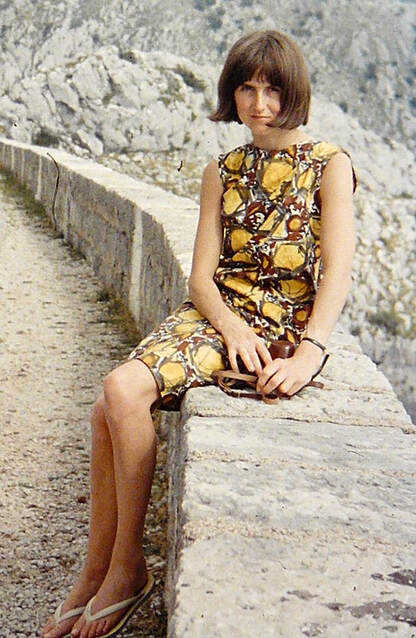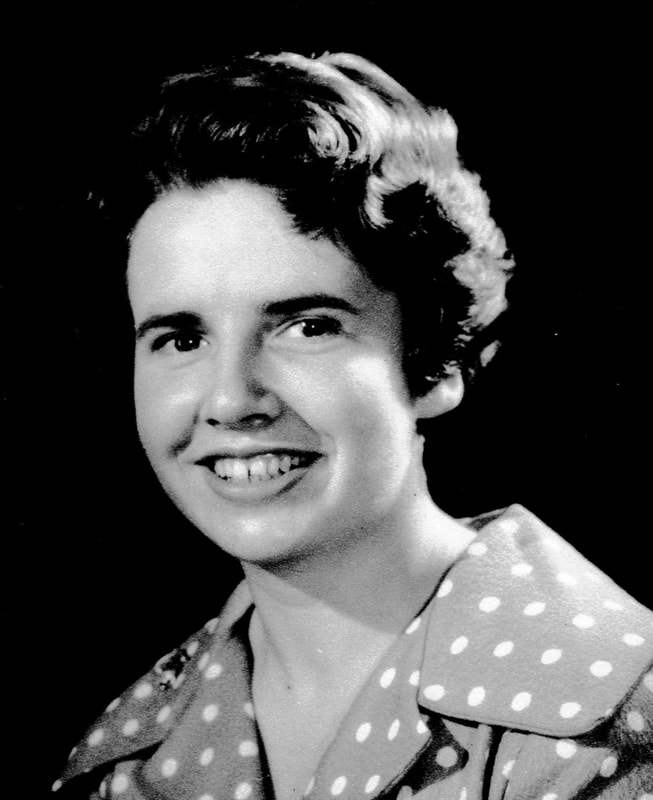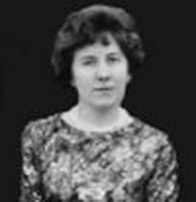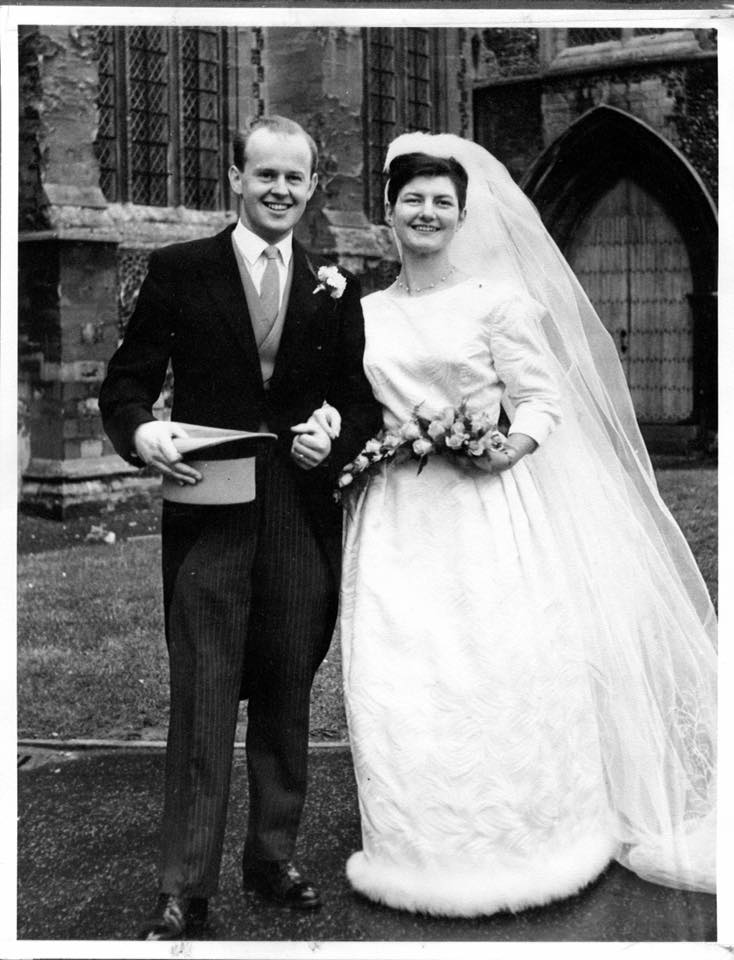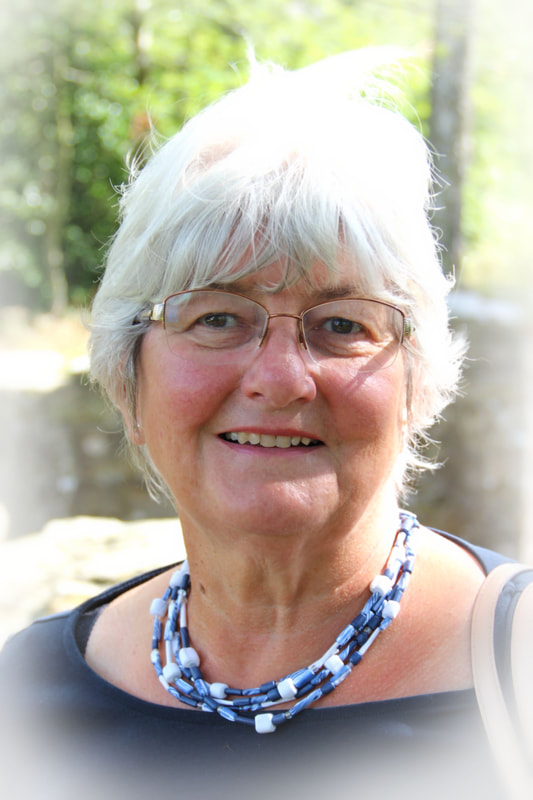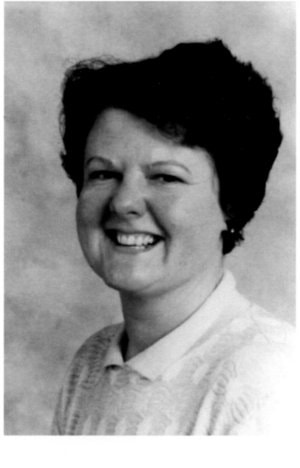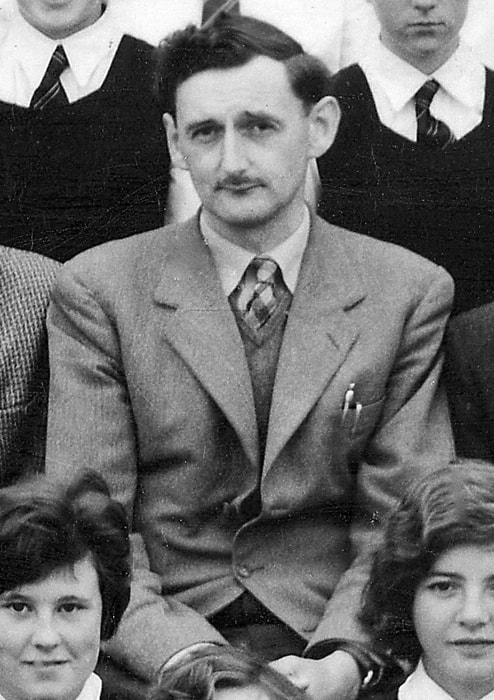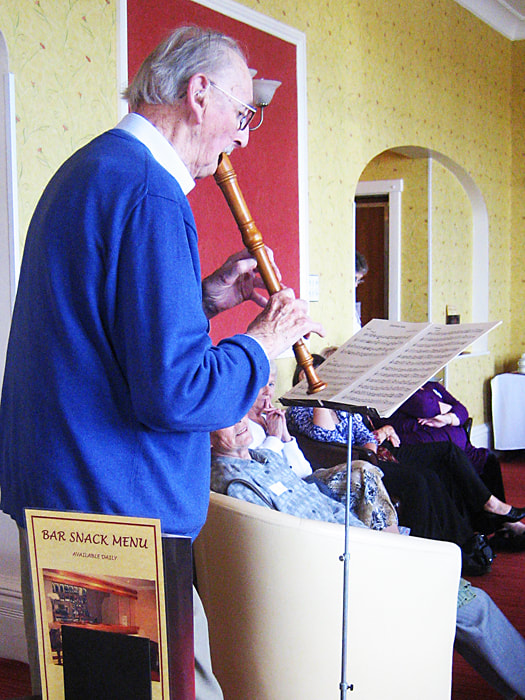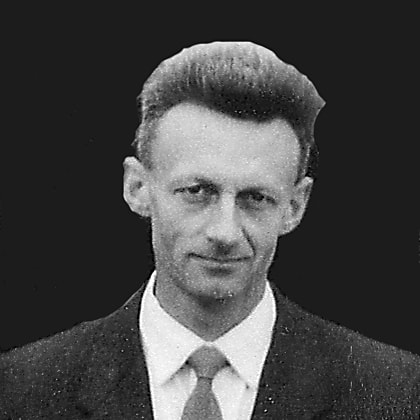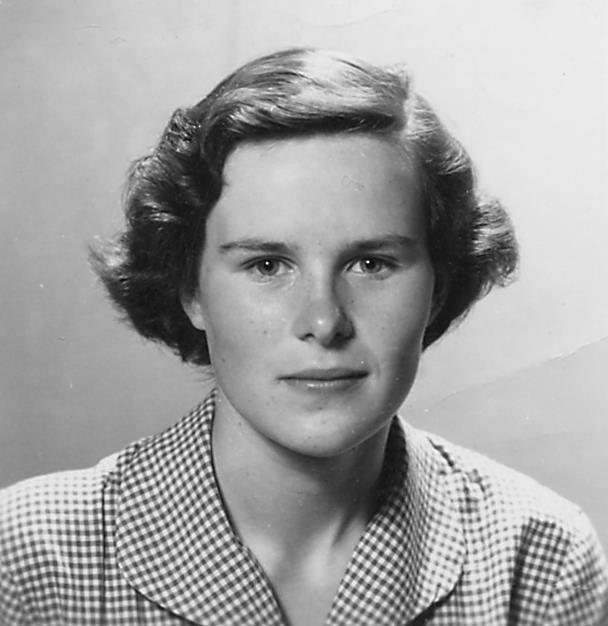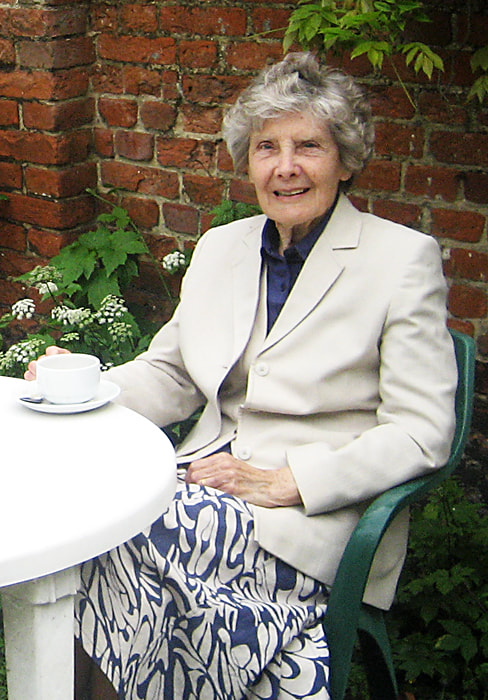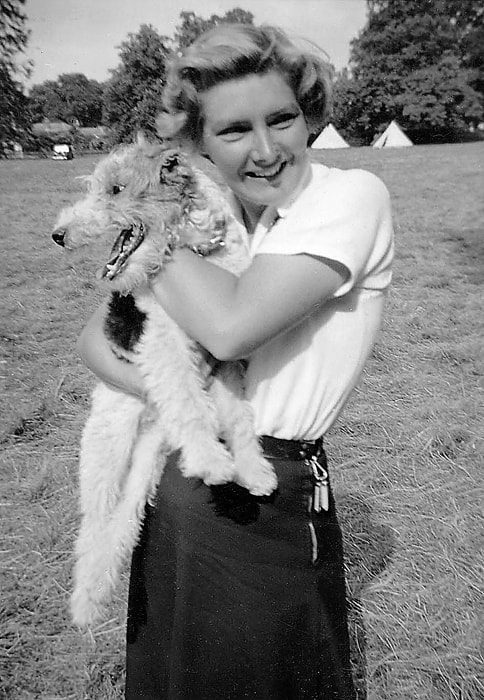Ann Milroy 1942 - 2019
Ann was at Great Yarmouth High School for Girls from 1956 to 1960.
She was born in Gainsborough in 1942. When her father returned from the army and
rejoined the National and Provincial Bank, the family moved to Ipswich and then to
Great Yarmouth. They lived in Beatty Road, a good cycle ride from the school once it
had moved, in 1957, to its new premises in Lynn Grove. She arrived at the beginning
of the two-year preparation for "O" Level, joining the Lower V. Among the subjects
she studied then was Ancient Greek. Her favourite subject at "A" Level was English.
After leaving school, Ann worked in Norwich public library, commuting by train.
In 1961, the family moved again, this time to Richmond in North Yorkshire. Ann
continued working in libraries (in Richmond and nearby Catterick Camp) until she
went to study at the Library School in Newcastle upon Tyne, now part of Northumbria
University. After qualifying, Ann worked on the mobile libraries that served the pit
villages of Northumberland and then in a public library in Newburn. She then moved
to London, living in Finchley then moving south of the river to Wimbledon, and
worked in libraries for Visnews (newsfilm) and Philips & Drew (stockbrokers) before
joining the Electricity Council’s library. She then moved to servicing national
electricity supply industry committees and panels of inquiry. At privatisation she
moved to National Grid and, after redundancy from there, took on part-time admin
work for the Electricity Association.
Ann liked to keep in touch with friends from different times of her life. She regularly
travelled back to all these places and enjoyed holidays on the continent, in South
Africa and, after discovering Canadian cousins, in Alberta.
She suffered from syringomyelia, a disease of the spinal cord, which gradually
impaired her mobility. When she could no longer live in her own house, Ann moved
into a flat in a care home in Wimbledon. Although she could no longer travel, she
was always pleased to receive visitors. Ann kept up with news of Old Girls through
the school website and through her classmate Carole (Dane) Owen. In 2017 they
were both pleased to have lunch with another class-mate (and cat-lover), Ann
Philips. They hadn't seen Ann since VI Form days. In 2019 Judith (Dawes) Parlby
travelled from Luton to join them for lunch with Ann and her brother Peter.
Ann had kept up her friendship with Anthea Cullington after they left school.
The two of them had some holidays together before Anthea emigrated to the USA.
Ann and Carole were delighted to meet Anthea in 2019 when she came to the U.K. to visit her sister.
The internet was a lifeline to Ann. She was a regular emailer and, with her
knowledge of genealogy, she researched family trees for many friends. She was
always a voracious reader (latterly an enthusiastic convert to Kindles) and
maintained a strong interest in watching sport, especially athletics and cricket. She
was a member of a local patchwork and quilting group and then did tapestries. She
was fond of pets; her last cat, Sophie, survived her by a few months.
Ann died of breast cancer in November 2019. She had a woodland burial in Surrey.
PETER MILROY, Ann's younger brother, with a little help from CAROLE DANE OWEN
Note from Carole
Peter's devoted care of Ann as she became ill was wonderful to see.
DIANA POULTON
We were sorry to hear of the death of Diana Poulton. She joined the1953 intake in 1955 when her
father became the professional at Caister Golf Club. She took O Levels in 1958 and A Levels in
1960. Her husband kindly sent us this summary of her life and the photograph of Diana in 1960.
After graduating with a BSc from Hull University, Diana taught Mathematics
at GYHS until a break for her children’s early years. She then taught at Oriel
High School and later at Gt. Yarmouth College.
She married David Savory in 1965, having three children – Stephen, Michael
& Jane. In 1996 Diana & David moved to the beautiful Isle of Barra in the
Outer Hebrides, renovated an old school, and opened a B&B and Self-
Catering business. This proved very successful, but she was still able to find
the time to further her love of baking and gardening.
In 2010 they returned to the mainland, settling in the Scottish Borders near
Kelso to be close to their daughter. In February 2020 they joined Jane & her
husband in sharing a large former manse in Kelso, but soon after, Diana was
diagnosed with a brain tumour which led to her death in October 2020.
She was a most loving wife, mother and grandmother; she benefited from a
wide friendship group; she is greatly missed.
We were sorry to hear of the death of Diana Poulton. She joined the1953 intake in 1955 when her
father became the professional at Caister Golf Club. She took O Levels in 1958 and A Levels in
1960. Her husband kindly sent us this summary of her life and the photograph of Diana in 1960.
After graduating with a BSc from Hull University, Diana taught Mathematics
at GYHS until a break for her children’s early years. She then taught at Oriel
High School and later at Gt. Yarmouth College.
She married David Savory in 1965, having three children – Stephen, Michael
& Jane. In 1996 Diana & David moved to the beautiful Isle of Barra in the
Outer Hebrides, renovated an old school, and opened a B&B and Self-
Catering business. This proved very successful, but she was still able to find
the time to further her love of baking and gardening.
In 2010 they returned to the mainland, settling in the Scottish Borders near
Kelso to be close to their daughter. In February 2020 they joined Jane & her
husband in sharing a large former manse in Kelso, but soon after, Diana was
diagnosed with a brain tumour which led to her death in October 2020.
She was a most loving wife, mother and grandmother; she benefited from a
wide friendship group; she is greatly missed.
Mrs Jeannie Gunn (Miss Robertson) LRAM
We were very sorry to hear that Jeannie Gunn, (Miss Robertson, remembered in separate articles on this website) has died, aged 89. As well as teaching science, and leading so much school-based drama, she was an active member of both The Masquers and the local Gilbert and Sullivan Society. She and her husband David, who was also a teacher, shared a passion for drama and music. They led many productions at the Windmill Theatre and elsewhere.
After she was widowed, Jeannie moved to Edinburgh to live near to her son Andrew, and daughter-in-law Natalia. She was for many years a very active grandmother in the lives of her two grandchildren, and also volunteered as a guide at St Mary’s Cathedral.
Jeannie’s father was involved in the fishing industry, and so she had spent part of her childhood in Yarmouth, and part in north-east Scotland. From the balcony of her flat she was able to look towards the sea, and all through the year of lockdown, she walked briskly every day along the shore.
A person of strong faith, she has been laid to rest along with David at St Bartholomew’s Church, Corton.
We were very sorry to hear that Jeannie Gunn, (Miss Robertson, remembered in separate articles on this website) has died, aged 89. As well as teaching science, and leading so much school-based drama, she was an active member of both The Masquers and the local Gilbert and Sullivan Society. She and her husband David, who was also a teacher, shared a passion for drama and music. They led many productions at the Windmill Theatre and elsewhere.
After she was widowed, Jeannie moved to Edinburgh to live near to her son Andrew, and daughter-in-law Natalia. She was for many years a very active grandmother in the lives of her two grandchildren, and also volunteered as a guide at St Mary’s Cathedral.
Jeannie’s father was involved in the fishing industry, and so she had spent part of her childhood in Yarmouth, and part in north-east Scotland. From the balcony of her flat she was able to look towards the sea, and all through the year of lockdown, she walked briskly every day along the shore.
A person of strong faith, she has been laid to rest along with David at St Bartholomew’s Church, Corton.
Vivienne Brenda Osborne (born Amos), 11th February 1941 – 22nd February
2020
Vivienne Brenda Osborne (born Amos), 11th February 1941 – 22nd February 2020
At her funeral, the celebrant said, “Viv was loved and respected; she touched many lives and hearts. Knowing what a lively, vibrant, joyous, intelligent, creative person Vivienne was for most of her life, it is particularly hard to accept how severe the deterioration in her last years was.”
After nearly nearly three years of puzzling, struggling, searching the diagnosis was PSP (Progressive Supra Nuclear Palsy)
.
Vivienne began life in inauspicious circumstances in a house in Rochdale, Lancashire. Delivered by her maternal grandmother, she was a breech birth, born to a mother with scarlet fever. Times were hard for the family. Her father, Edward, was in the RAF, a navigator in a Lancaster bomber and part of the various dangerous raids into Germany, so away from the family. Doris May, Viv’s mother, had two children already, John and Patricia, and later another son, Malcolm. Thankfully the family had support from Doris’ parents, who lived nearby.
The house backed onto a golf course and Viv remembered scouting for lost golf balls, selling them back to the players. At times she wore clogs and part of the walk to school was along the ridge of a high stone wall. Aged 8 she had an operation for gynaecological problems and at 10 she contracted tuberculosis. At that time the survival rate was not good, but with care, milk obtained by neighbours contributing their coupons during rationing, and during the long convalescence she educated herself from books that were available. Part of the recovery was for the family to move to a cleaner environment, achieved when Viv’s father got a job as Customs and Excise Officer in Great Yarmouth.
The family had not been in the area long when the 1953 flood hit. Having to evacuate, the family were offered accommodation by an elderly lady they knew from church, who was willing to take a family of six into her small house.
In spite of this trauma Viv thrived. She was a bright child, who excelled in most things, immediately going to the top of the class at her primary school, The Edward Worlledge. She became part of a physical culture club that performed display gymnastics for shows and the summer visitors. She swam and dived well and was a very good sprinter. She went to Great Yarmouth High School (for girls) in 1952.
On the sports field she excelled at hockey, playing for the school and being selected for the county team. Having played about four matches, this was then curtailed when, aged 17, she contracted rheumatic fever and was advised to reduce her physical activities. Academically, Viv did well in all subjects. She particularly loved Latin, mainly because of an excellent teacher, Miss Mumford, who remained a friend all her life. Viv was strong on sciences but regretted the school custom that you were either a science student or arts. Outside school Viv worked at the kiosk at the Floral Hall – a dance hall and swimming pool on Gorleston front – earning money and also free entry to the pool, which she loved. She was also a member of the Borough Youth Council which was so advanced for the time, set up by Mr Stanley.
On leaving she gained a place at Exeter University to study zoology She gained employment with the pharmaceutical company May and Baker and was involved in the research that led to the development of the first cardiovascular drugs, which enabled the first heart transplant operations. This was also the time of the thalidomide drugs and by the nature of her work May and Baker avoided the serious errors made by the German firm which produced it. She enjoyed that work and had good friends.
Romance came not long after. Through a mutual friend in London she met David Osborne (who had been a student at Great Yarmouth Grammar School). Their partnership flourished, though to Viv’s horror David announced he wanted to leave business and go into teaching. When he asked her if she thought he would make a good teacher, her reply was an emphatic ‘no’! He went ahead anyway, and although they were by then engaged, he got a teaching job in Yorkshire, West Riding, which is where they established their first house and where their first two children, Gillian and Sally, were born.
They became a good team, working together on the houses (Pudsey, Thorpe Audlin, Jersey, Beccles), the gardens, the children, their life and this continued for 53 years, until Viv’s final illness took hold and stopped most of her physical activities.
During all those years Viv did so much. Briefly, at the start of her marriage, she agreed to take on a teaching job in Benton Park, an unpleasant secondary school in Rawdon, near Leeds, teaching biology to pre-nursing students of varying abilities – under her brief tenure their exam results were high. With David, she volunteered with the Duke of Edinburgh Award Scheme, tutoring and supporting students in what was at that time the only borough-based group in the country. Viv was always a willing and extremely able volunteer.
In the West Riding, Gillian was suffering with the dirty air and Viv and David resolved to find a better environment for the family. It worked out perfectly when in 1972 he got a Deputy Headship in Jersey, Channel Islands. The family flourished in a semi-detached house near the sea and Viv volunteered for work in the swimming pool with children who had terminal illnesses – she loved it and they loved her. She also volunteered with Channel Island radio collecting audio memories from elderly residents.
Six years later the family moved again, arriving in Beccles so that David could take up the headship at Hobart High School in Loddon. The following year, David once again asked for Viv’s help. Mock interviews for the school’s senior students had been arranged, when a fortnight before they were due to take place, the volunteer interviewers cancelled. Knowing his wife's abilities, David rang Viv, asking her to arrange a group of 12 interviewers from local people with business backgrounds. That was no problem for Viv, and she continued to do it for the next 22 years!
In fact it’s hard to think of any challenge Viv was faced with that she didn’t rise to, though she remained thoroughly modest about her achievements and never sought accolades for herself. If something needed doing, Viv would take it on (and this is by no means an exhaustive list):
A competent artist in oils and pastels, she painted scenery and made props for Loddon Pantomime Players. Always community minded, Viv was asked in 1986 to join the Committe which was setting up an Abbeyfield Home for the lonely elderly in Beccles. She played a significant part in this, becoming House Chairman. She volunteered with Save the Children, in which role she helped organise a major event at Sandringham Palace, directly organising three entertainment arenas that ran concurrently throughout the afternoon. She was invited to become a lay member of Ofsted’s school inspection teams, passed the exams and became deputy lead inspector by her third inspection. She was elected as a trustee for the Fauconberge Education Charitable Trust in 1998, serving as chairman for eight years from 2010, only resigning due to illness.
In Beccles Viv was a committee member of the Beccles and District Historical Society, devised the Yearbook, using her knowledge of Microsoft Publisher to produce a very professional information booklet for members. She was also the librarian and poster designer for Beccles Choral Society and part of a small group who researched and published the history of the bells in Beccles. With David, she organised and led annual residential excursions for the Beccles Historical Society for 10 years.
Viv was no less busy at home. An expert knitter, seamstress and needlewoman, she made curtains for the five houses they lived in and clothes for the family, and she and David refurbished and reupholstered the lounge suite. And she designed the garden at 15 Upper Grange Road and did a major part of the work herself.
It made no difference if the task was something Viv had absolutely no experience of: responding to daughter Sally’s request for a new tenor viol, Viv made an impressive instrument. And when the dentist – a friend – telephoned and said, ‘Viv, can you come straight away. I’m in the middle of a root canal operation and my assistant has had an asthma attack. Get a white coat from the cupboard as you come in’, Viv got on her bike and was there within minutes! As more than one person has said – she was a remarkable woman.
In the many cards David has received Viv is described as kind, funny, bubbly and easy to talk to; able, articulate, generous, loving and lovable; wonderfully warm with so much zest for life; a supportive friend and neighbour, and a great listener; remembered for her laugh, her sense of fun and her enthusiasm for life – someone who was very much loved and is very much missed.
There is a Facebook closed group celebrating Vivienne’s life. If anyone would like to access it, please contact David 01502 471878.
At her funeral, the celebrant said, “Viv was loved and respected; she touched many lives and hearts. Knowing what a lively, vibrant, joyous, intelligent, creative person Vivienne was for most of her life, it is particularly hard to accept how severe the deterioration in her last years was.”
After nearly nearly three years of puzzling, struggling, searching the diagnosis was PSP (Progressive Supra Nuclear Palsy)
.
Vivienne began life in inauspicious circumstances in a house in Rochdale, Lancashire. Delivered by her maternal grandmother, she was a breech birth, born to a mother with scarlet fever. Times were hard for the family. Her father, Edward, was in the RAF, a navigator in a Lancaster bomber and part of the various dangerous raids into Germany, so away from the family. Doris May, Viv’s mother, had two children already, John and Patricia, and later another son, Malcolm. Thankfully the family had support from Doris’ parents, who lived nearby.
The house backed onto a golf course and Viv remembered scouting for lost golf balls, selling them back to the players. At times she wore clogs and part of the walk to school was along the ridge of a high stone wall. Aged 8 she had an operation for gynaecological problems and at 10 she contracted tuberculosis. At that time the survival rate was not good, but with care, milk obtained by neighbours contributing their coupons during rationing, and during the long convalescence she educated herself from books that were available. Part of the recovery was for the family to move to a cleaner environment, achieved when Viv’s father got a job as Customs and Excise Officer in Great Yarmouth.
The family had not been in the area long when the 1953 flood hit. Having to evacuate, the family were offered accommodation by an elderly lady they knew from church, who was willing to take a family of six into her small house.
In spite of this trauma Viv thrived. She was a bright child, who excelled in most things, immediately going to the top of the class at her primary school, The Edward Worlledge. She became part of a physical culture club that performed display gymnastics for shows and the summer visitors. She swam and dived well and was a very good sprinter. She went to Great Yarmouth High School (for girls) in 1952.
On the sports field she excelled at hockey, playing for the school and being selected for the county team. Having played about four matches, this was then curtailed when, aged 17, she contracted rheumatic fever and was advised to reduce her physical activities. Academically, Viv did well in all subjects. She particularly loved Latin, mainly because of an excellent teacher, Miss Mumford, who remained a friend all her life. Viv was strong on sciences but regretted the school custom that you were either a science student or arts. Outside school Viv worked at the kiosk at the Floral Hall – a dance hall and swimming pool on Gorleston front – earning money and also free entry to the pool, which she loved. She was also a member of the Borough Youth Council which was so advanced for the time, set up by Mr Stanley.
On leaving she gained a place at Exeter University to study zoology She gained employment with the pharmaceutical company May and Baker and was involved in the research that led to the development of the first cardiovascular drugs, which enabled the first heart transplant operations. This was also the time of the thalidomide drugs and by the nature of her work May and Baker avoided the serious errors made by the German firm which produced it. She enjoyed that work and had good friends.
Romance came not long after. Through a mutual friend in London she met David Osborne (who had been a student at Great Yarmouth Grammar School). Their partnership flourished, though to Viv’s horror David announced he wanted to leave business and go into teaching. When he asked her if she thought he would make a good teacher, her reply was an emphatic ‘no’! He went ahead anyway, and although they were by then engaged, he got a teaching job in Yorkshire, West Riding, which is where they established their first house and where their first two children, Gillian and Sally, were born.
They became a good team, working together on the houses (Pudsey, Thorpe Audlin, Jersey, Beccles), the gardens, the children, their life and this continued for 53 years, until Viv’s final illness took hold and stopped most of her physical activities.
During all those years Viv did so much. Briefly, at the start of her marriage, she agreed to take on a teaching job in Benton Park, an unpleasant secondary school in Rawdon, near Leeds, teaching biology to pre-nursing students of varying abilities – under her brief tenure their exam results were high. With David, she volunteered with the Duke of Edinburgh Award Scheme, tutoring and supporting students in what was at that time the only borough-based group in the country. Viv was always a willing and extremely able volunteer.
In the West Riding, Gillian was suffering with the dirty air and Viv and David resolved to find a better environment for the family. It worked out perfectly when in 1972 he got a Deputy Headship in Jersey, Channel Islands. The family flourished in a semi-detached house near the sea and Viv volunteered for work in the swimming pool with children who had terminal illnesses – she loved it and they loved her. She also volunteered with Channel Island radio collecting audio memories from elderly residents.
Six years later the family moved again, arriving in Beccles so that David could take up the headship at Hobart High School in Loddon. The following year, David once again asked for Viv’s help. Mock interviews for the school’s senior students had been arranged, when a fortnight before they were due to take place, the volunteer interviewers cancelled. Knowing his wife's abilities, David rang Viv, asking her to arrange a group of 12 interviewers from local people with business backgrounds. That was no problem for Viv, and she continued to do it for the next 22 years!
In fact it’s hard to think of any challenge Viv was faced with that she didn’t rise to, though she remained thoroughly modest about her achievements and never sought accolades for herself. If something needed doing, Viv would take it on (and this is by no means an exhaustive list):
A competent artist in oils and pastels, she painted scenery and made props for Loddon Pantomime Players. Always community minded, Viv was asked in 1986 to join the Committe which was setting up an Abbeyfield Home for the lonely elderly in Beccles. She played a significant part in this, becoming House Chairman. She volunteered with Save the Children, in which role she helped organise a major event at Sandringham Palace, directly organising three entertainment arenas that ran concurrently throughout the afternoon. She was invited to become a lay member of Ofsted’s school inspection teams, passed the exams and became deputy lead inspector by her third inspection. She was elected as a trustee for the Fauconberge Education Charitable Trust in 1998, serving as chairman for eight years from 2010, only resigning due to illness.
In Beccles Viv was a committee member of the Beccles and District Historical Society, devised the Yearbook, using her knowledge of Microsoft Publisher to produce a very professional information booklet for members. She was also the librarian and poster designer for Beccles Choral Society and part of a small group who researched and published the history of the bells in Beccles. With David, she organised and led annual residential excursions for the Beccles Historical Society for 10 years.
Viv was no less busy at home. An expert knitter, seamstress and needlewoman, she made curtains for the five houses they lived in and clothes for the family, and she and David refurbished and reupholstered the lounge suite. And she designed the garden at 15 Upper Grange Road and did a major part of the work herself.
It made no difference if the task was something Viv had absolutely no experience of: responding to daughter Sally’s request for a new tenor viol, Viv made an impressive instrument. And when the dentist – a friend – telephoned and said, ‘Viv, can you come straight away. I’m in the middle of a root canal operation and my assistant has had an asthma attack. Get a white coat from the cupboard as you come in’, Viv got on her bike and was there within minutes! As more than one person has said – she was a remarkable woman.
In the many cards David has received Viv is described as kind, funny, bubbly and easy to talk to; able, articulate, generous, loving and lovable; wonderfully warm with so much zest for life; a supportive friend and neighbour, and a great listener; remembered for her laugh, her sense of fun and her enthusiasm for life – someone who was very much loved and is very much missed.
There is a Facebook closed group celebrating Vivienne’s life. If anyone would like to access it, please contact David 01502 471878.
Annette Rosemary Grace Stringer 9th April 1947 - 10th September 2019
Annette attended GYHS from 1958-1965. She was a keen member of the school guide company, the 5th Great Yarmouth.
After 'A' Levels she went to Bulmershe College at Reading for teacher training and then taught for one year in Meadow Primary School, Lowestoft, and then for five years at Cliff Park Junior School, Gorleston.
Her next career move was to York School, Munster, Germany, with the British Forces Education Service. She spent five years there before returning to Cliff Park, now a Middle School, in 1979.
By then, teaching had changed. Stress began to take its toll and in 1994, after 26 years in the profession and at the age of only 47, she received very early retirement on health grounds. But she carried on helping children. She ran a lunchtime club and heard children read at Gunton Primary School for 19 years, and she sponsored a girl in India and one in Sri Lanka through their education.
One of Annette's main interests was travel and she visited many countries. She was always keen to see how other communities lived.
She had an active social life and was a member of a number of organizations, among them Lowestoft Scrabble Club, Lowestoft East Point Rotary Club, and our own GYHSOG Association.
Adapted from Annette's own account of her life. This was read at her memorial service at St. Mark's Oulton Broad, the church that she attended.
Mr Ronald Skins Music and English Teacher 10 February 1922 – 25 April 2019
Ronald Skins 10 February 1922 – 25 April 2019
Ron was born in the Leicestershire village of Buckminster, where he grew up. In his nineties, he wrote a very interesting memoir of his life in the village.
Ron was an outstanding musician. Himself an expert player of many kinds of recorder, he did much to encourage recorder-playing. He set up the school recorder club. He also set up his own consort, which he directed in Norwich and churches in East Anglia for decades. He was the Norfolk representative of the National Society of Recorder Players.
He ended his days living happily with his daughter Kate in the Pyrenees, and died peacefully with his family around him at the age of 97.
Clare Galloway writes:
I got to know Mr Skins in the music context. Recorders were his passion and he was happy to share his love of recorder music with us, the pupils. He was a member of NSRP - the National Society of Recorder Players - and took part in weekend playing days. I was fortunate to take part in these, in GYHS and occasionally elsewhere. Sometimes I used to take my recorder (and my packed lunch) to the far-flung location of Lowestoft - once, the famous virtuoso Carl Dolmetsch joined us, which was exciting for a (very) junior player. From GYHS we also took part in events requiring recorders – such as Benjamin Britten's Noye's Fludde, in the Town Hall, and the school staging of Molière's play Le Bourgeois Gentilhomme. Two of us dressed up in satin britches in a Renaissance style! Mr Skins was kind and gentle and always supportive. I can't ever remember him being ‘teacherish’ in any way!
A few of the comments from Facebook: Great Yarmouth High School Old Girls Association
He kindled my love of Shakespeare
A very kind and gentle man
A kind, gentleman teacher with great passion for English and music.
A wonderful and inspirational teacher. I will always remember his beautiful copperplate handwriting - in chalk on a blackboard! I was in his recorder group for several years - he introduced us to the various crumhorns and other varieties of recorders I hadn’t known existed. Remembering too his lovely daughter Kate - best wishes to her and all the family. A truly lovely man.
Great respect for a highly intelligent, talented and modest colleague. (Barbara Tingey)
Mr. Skins was my form teacher and English Teacher. He epitomised the ‘gentle’ in gentleman throughout my time at school. The group gave me a lifeline and was so important to me.
One of the few men who helped to teach me what it really means to be a gentleman
I was taught by Ronald Skins in primary and secondary school. He taught me recorder in both and will go as far as saying that he fostered in me a love of music for life.
Ron was born in the Leicestershire village of Buckminster, where he grew up. In his nineties, he wrote a very interesting memoir of his life in the village.
Ron was an outstanding musician. Himself an expert player of many kinds of recorder, he did much to encourage recorder-playing. He set up the school recorder club. He also set up his own consort, which he directed in Norwich and churches in East Anglia for decades. He was the Norfolk representative of the National Society of Recorder Players.
He ended his days living happily with his daughter Kate in the Pyrenees, and died peacefully with his family around him at the age of 97.
Clare Galloway writes:
I got to know Mr Skins in the music context. Recorders were his passion and he was happy to share his love of recorder music with us, the pupils. He was a member of NSRP - the National Society of Recorder Players - and took part in weekend playing days. I was fortunate to take part in these, in GYHS and occasionally elsewhere. Sometimes I used to take my recorder (and my packed lunch) to the far-flung location of Lowestoft - once, the famous virtuoso Carl Dolmetsch joined us, which was exciting for a (very) junior player. From GYHS we also took part in events requiring recorders – such as Benjamin Britten's Noye's Fludde, in the Town Hall, and the school staging of Molière's play Le Bourgeois Gentilhomme. Two of us dressed up in satin britches in a Renaissance style! Mr Skins was kind and gentle and always supportive. I can't ever remember him being ‘teacherish’ in any way!
A few of the comments from Facebook: Great Yarmouth High School Old Girls Association
He kindled my love of Shakespeare
A very kind and gentle man
A kind, gentleman teacher with great passion for English and music.
A wonderful and inspirational teacher. I will always remember his beautiful copperplate handwriting - in chalk on a blackboard! I was in his recorder group for several years - he introduced us to the various crumhorns and other varieties of recorders I hadn’t known existed. Remembering too his lovely daughter Kate - best wishes to her and all the family. A truly lovely man.
Great respect for a highly intelligent, talented and modest colleague. (Barbara Tingey)
Mr. Skins was my form teacher and English Teacher. He epitomised the ‘gentle’ in gentleman throughout my time at school. The group gave me a lifeline and was so important to me.
One of the few men who helped to teach me what it really means to be a gentleman
I was taught by Ronald Skins in primary and secondary school. He taught me recorder in both and will go as far as saying that he fostered in me a love of music for life.
Mr Skins playing a recorder at the 2013 reunion of the 1953 in take
Mr Peter Newton Geography Teacher and former Deputy Headmaster - Died 2019
Mr Peter Newton, remembered by a former pupil
I remember Mr Newton as a very, very good teacher. The geography room on the top floor at the far corner of the High School teaching block, with its views over the sports field, and the stairs through the cupboard up to the observation area on the roof, were his special domain. The walls and shelves bore all kinds of stimulating resources, pictures, maps and models. In our third year (Upper IV N) he was also our form teacher, and that room was our base.
I can remember the first geography lesson, eleven years old, single desks in rows in alphabetical order, according to our surnames. Mr Newton announced that the best way to teach us geography would be to take us on a journey around the world. Just for an excited second, I thought that’s what he was going to do. He had caught my attention all right. (The furthest I’d ever been was London.) But of course, we couldn’t do that; and so he’d be teaching us about the world in a different way.
That’s what he did. This may be a failure of my memory, but in five years up to GCSE, I don’t recall a single geography textbook. What I remember is Mr Newton’s enthusiasm for his subject, and how he engaged us with classic question-and-answer technique. Often there would be a single slide projected on a screen at the front of the room – a photograph of a particular landscape, or dwelling, or geographical feature. Through questions, standing at the projector, he’d make us look at it – really look at it - and think what information we could extract from it, what knowledge or imagination we could apply to it. We were learning the skill of seeking out information about the physical world, and its peoples, and analysing what it might mean – physical geography, and social and economic geography.
I remember learning to draw maps, and diagrams (always with titles and labels!), graphs, flow charts with pictures – for example the growing, harvesting, processing and shipment of the tea crop in India. We had to not just learn information, but compare – think about similarity and difference. How did farming on the maize belt of north America differ from a farm in Norfolk? We had to imagine what we would see on a journey from Shanghai up the Yangtze river valley thousands of miles on into Tibet. For homework we had to log wind direction and rainfall in our gardens over a couple of weeks; or make a model of a house from a different part of the world; or fill in names on one of Mr Newton’s traced handouts about geological formations, or maps, or diagrams showing why the sun was hotter at the equator. His marking was always prompt and thorough.
On one occasion we set out along Burgh Road and down a lane near Harfreys farm, from where we could see the two-mile spread of Yarmouth’s sand spit, and draw a profile of the built landscape. There were also films and visits after school via geography club – to a Yarmouth bottling factory, to a dairy farm.
Why are these memories so strong, even though I didn’t study geography after age 16? That’s what I put down to very good teaching!
I had the pleasure of going to visit Mr Newton a couple of years ago at his lovely house and garden in Suffolk. Over a cup of tea, we chatted about school and other things. I was interested to ask him his view about why Yarmouth had struggled economically and socially in recent years. He thought isolation and poor transport links were largely to blame; and he was opposed to Brexit, which he believed would cause more damage.
Although he’d been a very effective deputy head to Miss Evans, it seemed clear Mr Newton enjoyed teaching much more than school management. For example, he told me that he had finally despaired of trying to police the wearing of berets. I suspect being a parent of daughters gave him extra insight on the matter. He knew the resentment it caused, and he’d told Miss Evans he wasn’t willing to expend effort enforcing that rule anymore. She’d spent a weekend agonising over it – surely a dangerous erosion of standards! - but had finally relented. The school uniform became beret-free.
I’m glad I had that chance to thank Mr Newton for what I’d learned from him. He was a gifted, thoroughly professional teacher, and a thoughtful, charming man
I remember Mr Newton as a very, very good teacher. The geography room on the top floor at the far corner of the High School teaching block, with its views over the sports field, and the stairs through the cupboard up to the observation area on the roof, were his special domain. The walls and shelves bore all kinds of stimulating resources, pictures, maps and models. In our third year (Upper IV N) he was also our form teacher, and that room was our base.
I can remember the first geography lesson, eleven years old, single desks in rows in alphabetical order, according to our surnames. Mr Newton announced that the best way to teach us geography would be to take us on a journey around the world. Just for an excited second, I thought that’s what he was going to do. He had caught my attention all right. (The furthest I’d ever been was London.) But of course, we couldn’t do that; and so he’d be teaching us about the world in a different way.
That’s what he did. This may be a failure of my memory, but in five years up to GCSE, I don’t recall a single geography textbook. What I remember is Mr Newton’s enthusiasm for his subject, and how he engaged us with classic question-and-answer technique. Often there would be a single slide projected on a screen at the front of the room – a photograph of a particular landscape, or dwelling, or geographical feature. Through questions, standing at the projector, he’d make us look at it – really look at it - and think what information we could extract from it, what knowledge or imagination we could apply to it. We were learning the skill of seeking out information about the physical world, and its peoples, and analysing what it might mean – physical geography, and social and economic geography.
I remember learning to draw maps, and diagrams (always with titles and labels!), graphs, flow charts with pictures – for example the growing, harvesting, processing and shipment of the tea crop in India. We had to not just learn information, but compare – think about similarity and difference. How did farming on the maize belt of north America differ from a farm in Norfolk? We had to imagine what we would see on a journey from Shanghai up the Yangtze river valley thousands of miles on into Tibet. For homework we had to log wind direction and rainfall in our gardens over a couple of weeks; or make a model of a house from a different part of the world; or fill in names on one of Mr Newton’s traced handouts about geological formations, or maps, or diagrams showing why the sun was hotter at the equator. His marking was always prompt and thorough.
On one occasion we set out along Burgh Road and down a lane near Harfreys farm, from where we could see the two-mile spread of Yarmouth’s sand spit, and draw a profile of the built landscape. There were also films and visits after school via geography club – to a Yarmouth bottling factory, to a dairy farm.
Why are these memories so strong, even though I didn’t study geography after age 16? That’s what I put down to very good teaching!
I had the pleasure of going to visit Mr Newton a couple of years ago at his lovely house and garden in Suffolk. Over a cup of tea, we chatted about school and other things. I was interested to ask him his view about why Yarmouth had struggled economically and socially in recent years. He thought isolation and poor transport links were largely to blame; and he was opposed to Brexit, which he believed would cause more damage.
Although he’d been a very effective deputy head to Miss Evans, it seemed clear Mr Newton enjoyed teaching much more than school management. For example, he told me that he had finally despaired of trying to police the wearing of berets. I suspect being a parent of daughters gave him extra insight on the matter. He knew the resentment it caused, and he’d told Miss Evans he wasn’t willing to expend effort enforcing that rule anymore. She’d spent a weekend agonising over it – surely a dangerous erosion of standards! - but had finally relented. The school uniform became beret-free.
I’m glad I had that chance to thank Mr Newton for what I’d learned from him. He was a gifted, thoroughly professional teacher, and a thoughtful, charming man
Mr Newton with former pupil Judith Condon 2017
Maureen O'Brien Haworth 1941-2017
We are sorry to announce the death of Maureen Haworth, nee O'Brien
Maureen joined the High School in 1952 when she was only 10. She was a keen guide and hockey player as well as a prize-winning pupil. One of the highlights of her time at Great Yarmouth High School was her appearance in the German Goon Show organized by Mrs Jean Morris.
Perhaps at this distance in time it's safe to admit she could do a mean impersonation of a number of members of staff.
Maureen gained 'A' Levels in English,Latin and French, and went on to read English at Royal Holloway College, part of London University. She then taught English.
In 1969 she married Philip Haworth, a Lancashire man who worked in Operations Research for the Coal Board. For much of Philip's working life, they lived in Dore, near Sheffield. After the birth of her daughters, Katharine and Rachel, Maureen's main interest outside her home was working with and then running a play-group.
After her daughters had left home, Maureen moved back to Acle to look after her father. She and Phil lived at Staithe House, Upton for many years. There Maureen's interest was looking after her beautiful garden, which she was pleased to share with her cats, Polly and Miffy.
Maureen's family and friends will remember her great sense of humour and her love of words.
Maureen joined the High School in 1952 when she was only 10. She was a keen guide and hockey player as well as a prize-winning pupil. One of the highlights of her time at Great Yarmouth High School was her appearance in the German Goon Show organized by Mrs Jean Morris.
Perhaps at this distance in time it's safe to admit she could do a mean impersonation of a number of members of staff.
Maureen gained 'A' Levels in English,Latin and French, and went on to read English at Royal Holloway College, part of London University. She then taught English.
In 1969 she married Philip Haworth, a Lancashire man who worked in Operations Research for the Coal Board. For much of Philip's working life, they lived in Dore, near Sheffield. After the birth of her daughters, Katharine and Rachel, Maureen's main interest outside her home was working with and then running a play-group.
After her daughters had left home, Maureen moved back to Acle to look after her father. She and Phil lived at Staithe House, Upton for many years. There Maureen's interest was looking after her beautiful garden, which she was pleased to share with her cats, Polly and Miffy.
Maureen's family and friends will remember her great sense of humour and her love of words.
Anne Pashley 1935 - 2016
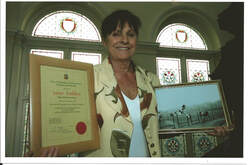
www.youtube.com/watch?v=y5NBSAcgtVQ
Anne Pashley 1935 - 2016
Telegraph Obituary:
Anne Pashley’s sporting prowess was spotted at school in Great Yarmouth and soon she was taking part in county championships and representing Britain around Europe. In 1953, while competing in the AAA championships at White City, she equalled the British women’s 100-yd record of 10.8 seconds; the following year she took bronze in the 100m at the European Games in Berne, Switzerland.
Anne Pashley takes the baton during Olympic relay practice in 1952 CREDIT: ANL/REX/SHUTTERSTOCKShe was selected as one of only nine women athletes representing her country at the Olympic Games, which were held in November 1956. She was considered a medal contender for the women’s 100m race, but in her heat she was allotted the inside track on the new cinder track, which had been disturbed by earlier runners. “It was really, really churned up,” she recalled. “It was like running on sand.” She was bitterly disappointed at failing to qualify.
The 4x100m relay provided her with a fresh opportunity. “I always loved the relay,” she said. “It was fun. I did the start, so it was quite a responsibility.” She set off at a phenomenal pace, quickly getting the better of Shirley Strickland (Australia), the Olympic hurdles champion, and being first to hand over the baton.
Anne Pashley training in 1955 CREDIT: REX FEATURESYet the Australians, whose team included Betty Cuthbert, the fastest woman in the world, soon gained the upper hand and took gold; the British team – Anne Pashley, Jean Scrivens, June Foulds and Heather Armitage – had to be content with silver, while the United States took bronze. Anne Pashley later recalled how, during the medal ceremony, it was “very difficult to get four people on a box”.
She beat Shirley Strickland in Sydney a few weeks later – “which was rather gratifying” – and then retired from the sport, though she later admitted to having misgivings. “I’m slightly sad that I gave up so soon,” she told the Eastern Daily Press in 2012, “but I was disappointed with the Olympic solo performance and... the Empire Games in Cardiff in two years’ time... didn’t seem a very exciting proposition.”
Back in London she entered the Guildhall School of Music, singing Cherubino in a student production of The Marriage of Figaro, and in 1959 made her debut in the Handel Opera Society’s production of Semele at Sadler’s Wells. Three years later she appeared in Die Zauberflöte at Glyndebourne and three years after that made her Covent Garden debut as Barbarina in Figaro. “Anne Pashley made about the best Siébel I can remember,” wrote a critic in Opera magazine of her performance in Faust at Sadler’s Wells in 1965. “She looked entirely convincing and performed in a most impassioned manner.”
Anne Pashley at the Melbourne Olympics in 1956 CREDIT: PAAnne Pashley was born at Skegness, Lincolnshire, on June 5 1935, the younger of two daughters of Roy, an English teacher, and his wife Milly, who also ran a local holiday camp. She was very young when the family moved to Stroud, Gloucester, for her father’s work. However, her asthma meant that when she was 14 the family were advised to relocate to the coast, ending up in Great Yarmouth.
Her athletic prowess was spotted at a schools’ competition where she took part in the 150-yard race. “When I finished I realised I was miles ahead, there was nobody within yards,” she recalled. “It was funny, quite a surprise.” She was recruited by Tom Parke, a coach at Great Yarmouth Athletics Club, whose coaching and advice she later said pointed her in the right direction.
After her Olympic success and change of direction she spent almost 30 years singing in opera houses and on television. When the curtain came down on her singing career Anne Pashley retired to a small town near Toulouse, in southwest France, where she enjoyed the company of her grandchildren, though arthritis meant that her sporting endeavours rarely went beyond playing table tennis with them.
In 2006 Great Yarmouth council invited her back to mark the 50th anniversary of her Melbourne medal. “It didn’t seem to have changed a great deal,” she said of the town, noting that whelks and fish and chips were still on sale in the market square. “It’s a lovely place. Some school friends turned up for that presentation.”
She preferred not to attend the London Olympics in person. “I hate big crowds and noises,” she explained. “So I’m going to sit and watch every moment of it on television – from canoeing to weightlifting.”
In 1959 Anne Pashley married Jack Irons, a tenor she had met at the Guildhall and with whom she occasionally performed duets. He died in 2005 and their son, Leon, died in 2013. She is survived by their daughter, Cleo.
Anne Pashley, born June 5 1935, died October 7 2016
Anne Pashley: La Mort de Cléopâtre by Berlioz
www.youtube.com/watch?v=y5NBSAcgtVQ
Anne Pashley 1935 - 2016
Telegraph Obituary:
Anne Pashley’s sporting prowess was spotted at school in Great Yarmouth and soon she was taking part in county championships and representing Britain around Europe. In 1953, while competing in the AAA championships at White City, she equalled the British women’s 100-yd record of 10.8 seconds; the following year she took bronze in the 100m at the European Games in Berne, Switzerland.
Anne Pashley takes the baton during Olympic relay practice in 1952 CREDIT: ANL/REX/SHUTTERSTOCKShe was selected as one of only nine women athletes representing her country at the Olympic Games, which were held in November 1956. She was considered a medal contender for the women’s 100m race, but in her heat she was allotted the inside track on the new cinder track, which had been disturbed by earlier runners. “It was really, really churned up,” she recalled. “It was like running on sand.” She was bitterly disappointed at failing to qualify.
The 4x100m relay provided her with a fresh opportunity. “I always loved the relay,” she said. “It was fun. I did the start, so it was quite a responsibility.” She set off at a phenomenal pace, quickly getting the better of Shirley Strickland (Australia), the Olympic hurdles champion, and being first to hand over the baton.
Anne Pashley training in 1955 CREDIT: REX FEATURESYet the Australians, whose team included Betty Cuthbert, the fastest woman in the world, soon gained the upper hand and took gold; the British team – Anne Pashley, Jean Scrivens, June Foulds and Heather Armitage – had to be content with silver, while the United States took bronze. Anne Pashley later recalled how, during the medal ceremony, it was “very difficult to get four people on a box”.
She beat Shirley Strickland in Sydney a few weeks later – “which was rather gratifying” – and then retired from the sport, though she later admitted to having misgivings. “I’m slightly sad that I gave up so soon,” she told the Eastern Daily Press in 2012, “but I was disappointed with the Olympic solo performance and... the Empire Games in Cardiff in two years’ time... didn’t seem a very exciting proposition.”
Back in London she entered the Guildhall School of Music, singing Cherubino in a student production of The Marriage of Figaro, and in 1959 made her debut in the Handel Opera Society’s production of Semele at Sadler’s Wells. Three years later she appeared in Die Zauberflöte at Glyndebourne and three years after that made her Covent Garden debut as Barbarina in Figaro. “Anne Pashley made about the best Siébel I can remember,” wrote a critic in Opera magazine of her performance in Faust at Sadler’s Wells in 1965. “She looked entirely convincing and performed in a most impassioned manner.”
Anne Pashley at the Melbourne Olympics in 1956 CREDIT: PAAnne Pashley was born at Skegness, Lincolnshire, on June 5 1935, the younger of two daughters of Roy, an English teacher, and his wife Milly, who also ran a local holiday camp. She was very young when the family moved to Stroud, Gloucester, for her father’s work. However, her asthma meant that when she was 14 the family were advised to relocate to the coast, ending up in Great Yarmouth.
Her athletic prowess was spotted at a schools’ competition where she took part in the 150-yard race. “When I finished I realised I was miles ahead, there was nobody within yards,” she recalled. “It was funny, quite a surprise.” She was recruited by Tom Parke, a coach at Great Yarmouth Athletics Club, whose coaching and advice she later said pointed her in the right direction.
After her Olympic success and change of direction she spent almost 30 years singing in opera houses and on television. When the curtain came down on her singing career Anne Pashley retired to a small town near Toulouse, in southwest France, where she enjoyed the company of her grandchildren, though arthritis meant that her sporting endeavours rarely went beyond playing table tennis with them.
In 2006 Great Yarmouth council invited her back to mark the 50th anniversary of her Melbourne medal. “It didn’t seem to have changed a great deal,” she said of the town, noting that whelks and fish and chips were still on sale in the market square. “It’s a lovely place. Some school friends turned up for that presentation.”
She preferred not to attend the London Olympics in person. “I hate big crowds and noises,” she explained. “So I’m going to sit and watch every moment of it on television – from canoeing to weightlifting.”
In 1959 Anne Pashley married Jack Irons, a tenor she had met at the Guildhall and with whom she occasionally performed duets. He died in 2005 and their son, Leon, died in 2013. She is survived by their daughter, Cleo.
Anne Pashley, born June 5 1935, died October 7 2016
Anne Pashley: La Mort de Cléopâtre by Berlioz
www.youtube.com/watch?v=y5NBSAcgtVQ
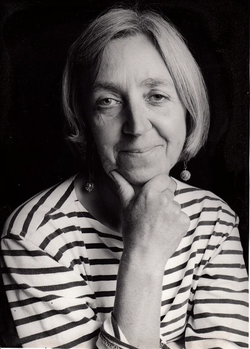
Caroline Lynas ( Newton ) - Born: 24/03/1955 - Passed away: 19/07/2016
Caroline died unexpectedly in her garden on 19 July 2016.
She was the daughter of Peter Newton, Deputy Head for many years and Head of Geography.
She was a keen supporter of the MS Trust and fundraised for them through her legendary jam sales.
For those who didn't know, she was suffering from MS and had been for many years but at times you would never know - as she did what we knew her to do, just got on with it.
Caroline had a promising career in medical research before she had to stop work and then she became a great support to her husband Stephen who is now the Senior Chaplain and Advisor to the Bishop of Wells.
Many an email would finish in - " must go - garden to sort out, fruit to pick, jam/cakes to make, Foreign students to look after, Bishops to entertain, French translations to do, riding , French classes to attend etc etc"
She seemed to be able to do all this and more.
Her personally made birthday cards were always special for you and her sense of humour shone through.
We shall miss greatly that sense of humour and the reminder that one is so lucky to be healthy.
Sally Frosdick nee Scamell 1935 - 2016
Sally was born in 1935 and died January 2016. We came to live in Gt.Yarmouth from London in 1950. Sally had already done one year of her O level studies and had to start again at the High School as it was a different Board. Sally's main interests at School were languages and Biology. She left in 1953 to train to be a nurse at the Middlesex Hospital in London.
In 1956 she married a Gt.Yarmouth boy, Gordon Frosdick. They lived in London for many years and had three sons. Sally at times was a Dental nurse, and worked in Fortnum and Masons in Piccadilly, where she met many interesting people. When Gordon retired , they came to live in Blofield, For at least 20 years, before Sally died she was an invalid, suffering from a number of illnesses
She kept herself busy. One of her projects was raising money for the erection of a memorial to people who died in Bomb Disposal during and after the war. It was eventually erected at Eden Camp in Yorkshire
Sally was very brave and patient with her health problems and always kept interested in the Arts, politics etc.
The above was sent to us by her sister, Anne Vafadari nee Scamell.
Sally was born in 1935 and died January 2016. We came to live in Gt.Yarmouth from London in 1950. Sally had already done one year of her O level studies and had to start again at the High School as it was a different Board. Sally's main interests at School were languages and Biology. She left in 1953 to train to be a nurse at the Middlesex Hospital in London.
In 1956 she married a Gt.Yarmouth boy, Gordon Frosdick. They lived in London for many years and had three sons. Sally at times was a Dental nurse, and worked in Fortnum and Masons in Piccadilly, where she met many interesting people. When Gordon retired , they came to live in Blofield, For at least 20 years, before Sally died she was an invalid, suffering from a number of illnesses
She kept herself busy. One of her projects was raising money for the erection of a memorial to people who died in Bomb Disposal during and after the war. It was eventually erected at Eden Camp in Yorkshire
Sally was very brave and patient with her health problems and always kept interested in the Arts, politics etc.
The above was sent to us by her sister, Anne Vafadari nee Scamell.
Dorothy Stevens nee Capon. "Miss Capon" 1922 - 2012
Dorothy Stevens (Miss Capon) (1922 – 2012)
It is with great sadness that we learned of the sudden death of Dorothy Stevens (Miss Capon) on 16 October 2012. She came to the school in 1947 to teach Physical Education, and left in 1972 when she married Hal Stevens, the popular ex-headmaster of Bungay Area School (now Bungay Middle School), where she taught before she came to the High School.
Dorothy was born in Lowestoft and went to Lowestoft Secondary School, where she excelled at games, especially hockey and tennis. She was in the school hockey team and in the Suffolk Ladies hockey team. She and her three sisters and her brother spent many happy hours on Lowestoft North Beach. Dorothy became a very good swimmer and came second in a race in Lowestoft harbour.
From school, Dorothy went to Keswick Training College near Norwich. It was during the Second World War and the college was bombed. Dorothy lost everything and went to her father in tears. She wasn't worried about her clothes or her books, but – horror of horrors – her hockey stick had been blown up.
Her first teaching post was at Kessingland. It was still war time. The authorities felt that it would be a good idea to put on some activity for Land Girls in the evenings, and Dorothy was asked to teach them country dancing. After a day's labour in the fields, the Land Girls were, understandably, not too keen on this.
When Dorothy arrived at Great Yarmouth High School for Girls, she was handed a pair of tweezers. This was for removing splinters from the bottoms of girls who had come to grief on the old wooden equipment in the gym.
Girls who were keen on games will remember her with gratitude. For them she was a very dedicated teacher who worked hard to help them to success. Among the stars of the games field was Anne Pashley, who went on to gain a bronze medal in the women's 100m in the 1954 European Championships in Berne and a silver medal as a member of the relay team in the 1956 Olympics in Australia. Dorothy used to recall Anne's first long jump at GYHS when she completely overshot the sand pit and landed on the grass the other side. Mr Jermy had to lengthen the sand-pit.
Other star pupils were Judith Starling, who won the Senior long jump event in the English Schools Championships in 1960, and Pat Donaldson, who played hockey for England.
It must be said, however, that with the less athletic and less interested in games she could be quite sharp and disparaging. They found this discouraging. They were further discouraged by their constant reports of 'X must try harder.' Or X must improve her posture.' They would have liked more attention to their needs and more encouragement.
Dorothy was asked to help with the school's Guide company, and did so happily, assisting the captain, Miss Taylor. Later she became an enthusiastic captain herself, constantly organizing hiking and camping. Through these activities, we learned about trees, flowers and animals. Dorothy gave many of us a lasting love of the great outdoors, particularly of wild flowers. In the Guides, we acquired practical skills useful in adult life, such as map-reading, bed-making, and how to give first aid. We had a lot of fun, making fires and cooking on them, tracking through woods, singing round a camp-fire in the dark. Dorothy set before us a standard of service to others and cheerfulness in adversity.
Hal was quite a bit older than Dorothy. When she married him in 1972 she gave up work in order to spend time with him. Thankfully, Hal lived to a good age, and they had 25 happy years together, both contributing a great deal to life in Bungay. Dorothy was president of Bungay Flower Club.
Those of us who attend the Old Girls lunches were amazed at how little age affected Dorothy's youthful appearance and smart turnout, her quick brain, her memory, and her zest for life. Latterly, she has looked younger than most of those she taught. When she took a couple of her old pupils for a walk last July, at the age of 89, she still walked like a woman in the prime of life. Her cheerfulness in old age has been a shining example to us. It was always a pleasure to see her, and we shall miss her very much.
Carole Dane Owen
It is with great sadness that we learned of the sudden death of Dorothy Stevens (Miss Capon) on 16 October 2012. She came to the school in 1947 to teach Physical Education, and left in 1972 when she married Hal Stevens, the popular ex-headmaster of Bungay Area School (now Bungay Middle School), where she taught before she came to the High School.
Dorothy was born in Lowestoft and went to Lowestoft Secondary School, where she excelled at games, especially hockey and tennis. She was in the school hockey team and in the Suffolk Ladies hockey team. She and her three sisters and her brother spent many happy hours on Lowestoft North Beach. Dorothy became a very good swimmer and came second in a race in Lowestoft harbour.
From school, Dorothy went to Keswick Training College near Norwich. It was during the Second World War and the college was bombed. Dorothy lost everything and went to her father in tears. She wasn't worried about her clothes or her books, but – horror of horrors – her hockey stick had been blown up.
Her first teaching post was at Kessingland. It was still war time. The authorities felt that it would be a good idea to put on some activity for Land Girls in the evenings, and Dorothy was asked to teach them country dancing. After a day's labour in the fields, the Land Girls were, understandably, not too keen on this.
When Dorothy arrived at Great Yarmouth High School for Girls, she was handed a pair of tweezers. This was for removing splinters from the bottoms of girls who had come to grief on the old wooden equipment in the gym.
Girls who were keen on games will remember her with gratitude. For them she was a very dedicated teacher who worked hard to help them to success. Among the stars of the games field was Anne Pashley, who went on to gain a bronze medal in the women's 100m in the 1954 European Championships in Berne and a silver medal as a member of the relay team in the 1956 Olympics in Australia. Dorothy used to recall Anne's first long jump at GYHS when she completely overshot the sand pit and landed on the grass the other side. Mr Jermy had to lengthen the sand-pit.
Other star pupils were Judith Starling, who won the Senior long jump event in the English Schools Championships in 1960, and Pat Donaldson, who played hockey for England.
It must be said, however, that with the less athletic and less interested in games she could be quite sharp and disparaging. They found this discouraging. They were further discouraged by their constant reports of 'X must try harder.' Or X must improve her posture.' They would have liked more attention to their needs and more encouragement.
Dorothy was asked to help with the school's Guide company, and did so happily, assisting the captain, Miss Taylor. Later she became an enthusiastic captain herself, constantly organizing hiking and camping. Through these activities, we learned about trees, flowers and animals. Dorothy gave many of us a lasting love of the great outdoors, particularly of wild flowers. In the Guides, we acquired practical skills useful in adult life, such as map-reading, bed-making, and how to give first aid. We had a lot of fun, making fires and cooking on them, tracking through woods, singing round a camp-fire in the dark. Dorothy set before us a standard of service to others and cheerfulness in adversity.
Hal was quite a bit older than Dorothy. When she married him in 1972 she gave up work in order to spend time with him. Thankfully, Hal lived to a good age, and they had 25 happy years together, both contributing a great deal to life in Bungay. Dorothy was president of Bungay Flower Club.
Those of us who attend the Old Girls lunches were amazed at how little age affected Dorothy's youthful appearance and smart turnout, her quick brain, her memory, and her zest for life. Latterly, she has looked younger than most of those she taught. When she took a couple of her old pupils for a walk last July, at the age of 89, she still walked like a woman in the prime of life. Her cheerfulness in old age has been a shining example to us. It was always a pleasure to see her, and we shall miss her very much.
Carole Dane Owen
